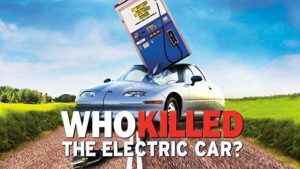In the early 1990s, California launched zero emission vehicle standards to improve air quality and fuel efficiency. While automakers initially complied and produced the first modern generation of commercial electric vehicles, they later lobbied to weaken the mandate. Thousands of electric cars were leased to consumers, but then were taken back and destroyed.
Plug In America was born during these challenging times.
In 2005, a passionate group of EV drivers rallied to galvanize citizen grassroots action to form DontCrush.com and saveEV1.com. They succeeded in saving at least 1,000 Ford and Toyota EVs from the crusher, however, GM still destroyed its innovative EV1 electric cars – despite the group’s offer to purchase the remaining 80 vehicles for $1.9 million.
 Images of the big yellow crusher at work in the documentary Who Killed the Electric Car? helped to spur further media attention, coupled with persistent protests, DontCrush.com press releases and organizational media savvy. Board member Sherry Boschert’s 2006 book, Plug-In Hybrids: The Cars That Will Recharge America, educated thousands of consumers leading the various advocacy groups to evolve into Plug In America.
Images of the big yellow crusher at work in the documentary Who Killed the Electric Car? helped to spur further media attention, coupled with persistent protests, DontCrush.com press releases and organizational media savvy. Board member Sherry Boschert’s 2006 book, Plug-In Hybrids: The Cars That Will Recharge America, educated thousands of consumers leading the various advocacy groups to evolve into Plug In America.
In August 2008, Plug In America officially registered its domain name and became a 501(c)(3) non-profit, as well as the nation’s largest organization dedicated to educating the public, automakers and policymakers on the efficacy and benefits of driving electric. Members now regularly organize and speak at national and regional events. Since 2011, the organization has co-hosted National Drive Electric Week with the Sierra Club and Electric Auto Association, which welcomed more than 180,000 attendees across 321 events in 2018, spanning all 50 states.
Plug In America has worked tirelessly to engage consumers to educate policymakers. Among its most influential work:
2009 | Supporters emailed over 50,000 letters to members of Congress resulting in the $7,500 tax credit for EV purchases being included in the stimulus package. |
2012 | Plug In America helped obtain HOV lane status for plug-in hybrid vehicles and an extension for all-electric vehicles in California. |
2016 | Plug In America helped to broaden the Washington sales tax exemption to include a wider range of vehicles. |
Today, Plug In America continues to bring awareness of the benefits and capabilities of plug-in electric vehicles.
The organization’s supporters have unparalleled day-to-day EV driving experience, which they leverage to continually document the dependability and performance of EVs, as well as provide invaluable data regarding vehicle performance and ownership. To find out how you can help, join us.